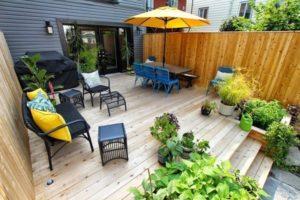Preparation
Preparing Cedar Outdoor Applications
The surface condition of the wood to which the finish is to be applied can substantially affect the performance and hence the life expectancy of the finish. The following procedures should prove helpful:
New Wood

For smooth-planed, flat-grained cedar, some surface preparation may be desirable. On flat-grained wood, the surface should be scuff-sanded with 50-60 grit sandpaper. This procedure will greatly increase the coatings performance but will not detract from a smooth finish. Surface preparation is not necessary for textured cedar.
Weathered New Wood
Weathered new wood that has been exposed to the elements for longer than 2 weeks may have a degraded surface that is unsuitable for painting. Preparing the surface by sanding, brushing, and washing before applying the finish is recommended.
Paint Finishes
Paint finishes must be removed if the old surface is severely peeled, blistered, or if cross-grain checking has occurred because of excessive paint build-up. The removal of a film-forming finish is also necessary if a penetrating stain or water-repellent finish is to be applied to a previously painted or solid-color stained surface. Note that changing from a film-forming to a penetrating finish sometimes does not give satisfactory results because residual paint inhibits absorption.
Read more : Tick Prevention for Cats
Finishes can be removed by sanding, wet sandblasting, pressurized water spray, electrically heated paint removers and chemicals. Although quick and easy, sandblasting and pressurized water spray are not recommended unless extreme care is taken to avoid damage to the wood’s surface. Special precautions to ensure worker safety must be taken if the old paint is of the lead-based type.
Weathered Water-Repellent Preservative Finishes
Weathered water-repellent preservative finishes should be cleaned with a non-ferrous bristle brush to remove loose fibers and dirt. If the surface is soiled, it may be scrubbed with a mild detergent solution. If mildew is present, it should be controlled. The surface should be thoroughly rinsed and allowed to dry completely before refinishing.
Caution: Never mix bleach with detergent containing ammonia as the fumes can be harmful or fatal.
Weathered Penetrating Stains
Weathered penetrating stains on mildew-free surfaces are relatively easy to refinish. Excessive scraping or sanding is not required. A stiff, non-ferrous bristle brush may be used to remove surface dirt, dust and loose wood fibers before applying the stain.
The Truth About “Mill Glaze”
Western Red Cedar is classified as a durable wood species, dimensionally stable, and suitable for a wide variety of coatings and finishes. It is these characteristics that make Western Red Cedar suitable for exterior use for many outdoor applications.
Read more : The Best Hot Tubs for Small Spaces
It has been proven through field studies and research that Western Red Cedar is an excellent substrate for coatings and finishes. When comparisons are made between Western Red Cedar and other wood species, Western Red Cedar outperforms them all.
Poor practices at construction sites, building design, and improper installation all have a negative impact on the performance of Western Red Cedar and coatings applied to it.
Many of the uninformed have attributed some coating failures on Western Red Cedar to “Mill Glaze”. They state that a varnish like glazing of extractives, resins, and sap will develop on the surface of the wood during the planing process interfering with the adhesion of the coating.
Western Red Cedar does not contain any sap or resins that can migrate to the surface. Western Red Cedar does contain extractives that make it resistant to insects and decay but they are not resinous or sap like. If Western Red Cedar became hot during the planning process, the surface would show burn marks. Researchers at the U.S. Forest Products Laboratory have not been able to duplicate paint failure by “glazing” at the surface.
The typical scenario where a coating company will cite mill glaze as the cause for coating failure on Western Red Cedar siding is:
- No primer
- One coat of solid color stain
- Spray applied
- Siding left exposed to the weather 4 weeks or more
- No building paper
- House with little or no overhang
- Siding delivered and stored unprotected on the ground where it took on moisture
- Siding not back-primed
- Blistering paint with water in the blisters
It is proven that textured surfaces hold coatings better than smooth surfaces. If the smooth face of Western Red Cedar is the graded face and the exposed face, light sanding will improve the performance of any finish.
Source: https://gardencourte.com
Categories: Outdoor
